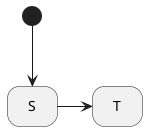Loading...
Searching...
No Matches
Completion Transition
Definition
A completion transition occurs whenever the source state is said to be complete. What determines the completion of a state depends on whether it's simple or composite.
From a Simple State
A simple state is considered complete right after its entry action is executed.
In the example below, right after a transition to S completes, the state machine transitions from S to T.

From a Composite State
A composite state is considered complete right after all its regions enter their final state.
In the example below, whenever every region of S enters its final state, the state machine transitions from S to T.

How to Define a Completion Transition with Maki
Pass maki::null in lieu of an event type:
(S, T, maki::null)
The final state is represented by maki::fin in transition tables:
(X0, maki::fin, maki::event<some_event>)